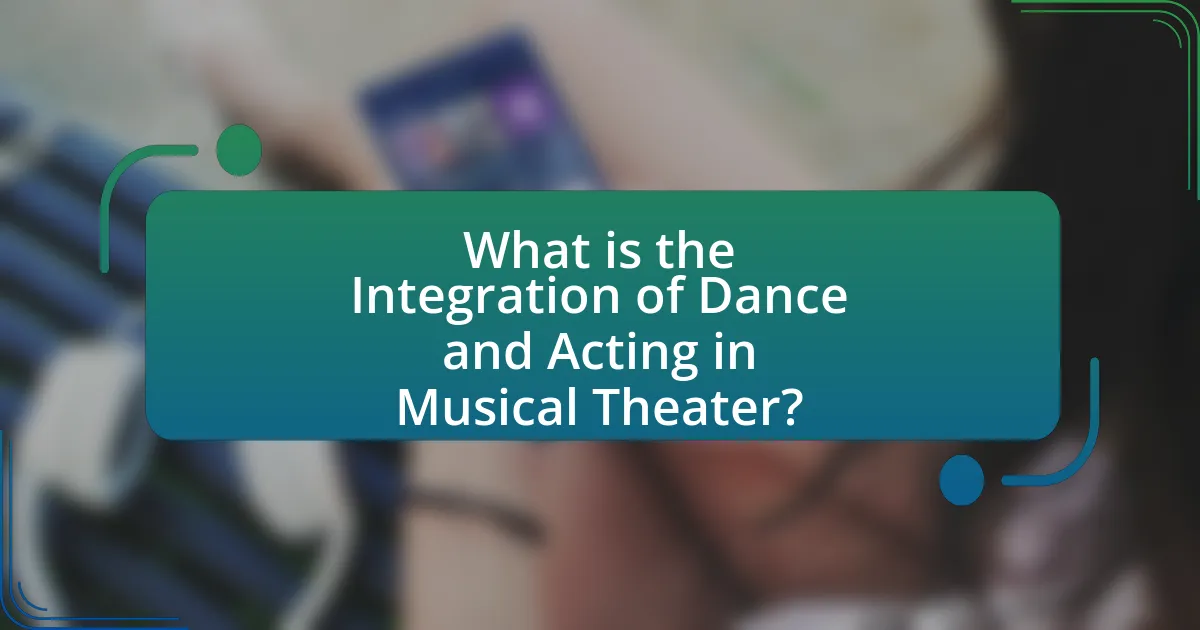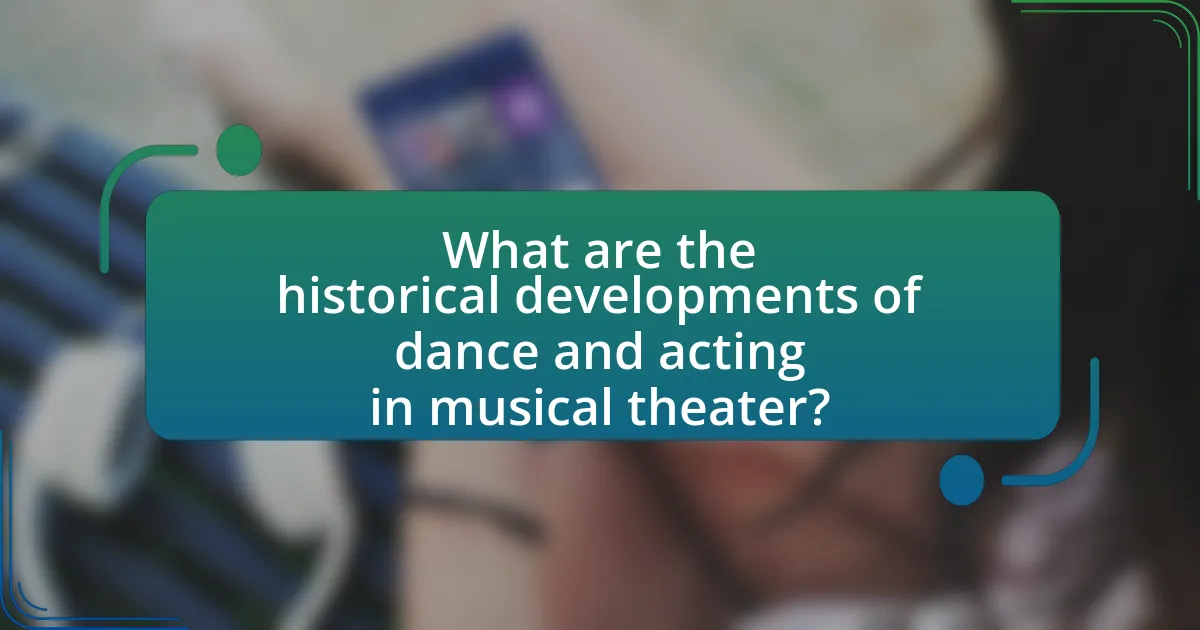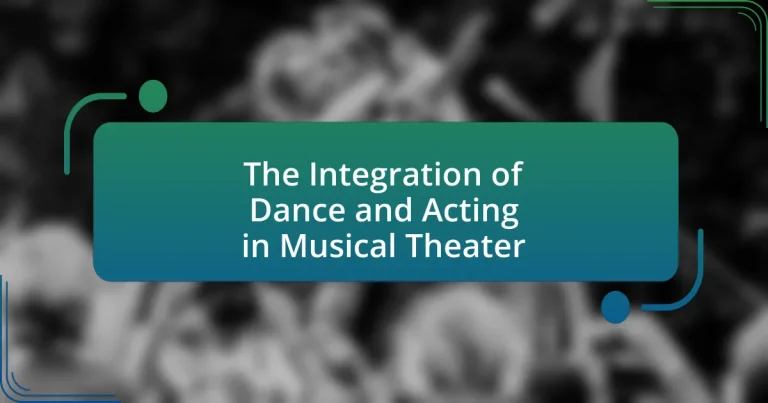The integration of dance and acting in musical theater is a crucial aspect that enhances storytelling and emotional expression. This article explores how these two disciplines complement each other, with a focus on character development, narrative progression, and the historical evolution of their relationship. Key elements such as body movement, rhythm, and emotional expression are examined, alongside the influence of choreography on plot advancement. Additionally, the article highlights current trends, challenges, and successful examples of integrated performances, providing practical tips for performers to improve their craft in this dynamic art form.

What is the Integration of Dance and Acting in Musical Theater?
The integration of dance and acting in musical theater is the seamless combination of movement and performance to convey a story and emotions. This integration enhances character development and narrative progression, allowing performers to express feelings and themes through both physicality and dialogue. Historical examples, such as the works of Jerome Robbins in “West Side Story,” demonstrate how choreography and acting work together to deepen the audience’s emotional connection to the characters and plot. Additionally, studies show that musicals with strong integration of these elements often receive higher critical acclaim and audience engagement, highlighting the importance of this synergy in the genre.
How do dance and acting complement each other in musical theater?
Dance and acting complement each other in musical theater by enhancing storytelling and emotional expression. In musical theater, dance serves as a physical manifestation of a character’s emotions and intentions, allowing performers to convey feelings that dialogue alone may not express. For instance, choreographed movements can illustrate a character’s internal struggle or joy, thereby deepening the audience’s understanding of the narrative. Additionally, the synchronization of dance and acting creates a cohesive performance, where the rhythm and energy of the dance align with the emotional beats of the acting, resulting in a more engaging and immersive experience for the audience. This integration is evident in productions like “West Side Story,” where the choreography is intricately linked to the characters’ arcs and the overall plot, demonstrating how dance and acting work together to enhance the storytelling in musical theater.
What are the key elements of dance that enhance acting performances?
The key elements of dance that enhance acting performances include body movement, rhythm, expression, and spatial awareness. Body movement allows actors to convey emotions and character traits through physicality, making performances more dynamic. Rhythm contributes to the timing and flow of dialogue and action, creating a cohesive performance. Expression in dance helps actors communicate feelings non-verbally, enriching the storytelling aspect. Spatial awareness enables performers to interact effectively with their environment and fellow actors, enhancing the overall visual impact of the performance. These elements collectively improve the depth and engagement of acting in musical theater.
How does acting influence the execution of dance in a musical?
Acting significantly influences the execution of dance in a musical by providing emotional context and character motivation that enhance the storytelling aspect of the performance. When dancers embody their characters through acting, their movements become more expressive and aligned with the narrative, allowing the audience to connect more deeply with the story. For instance, in productions like “West Side Story,” the choreography is intricately linked to the characters’ emotions and relationships, demonstrating how acting informs the physicality of dance. This integration ensures that the dance is not merely a series of movements but a vital component of the overall narrative, reinforcing the themes and emotions portrayed on stage.
Why is the integration of dance and acting important in storytelling?
The integration of dance and acting is crucial in storytelling because it enhances emotional expression and character development. When dance is combined with acting, it allows performers to convey complex emotions and narratives that words alone may not fully express. For instance, in musical theater, choreographed movements can symbolize a character’s internal struggles or relationships, making the story more engaging and relatable to the audience. This synergy between dance and acting has been historically significant, as seen in productions like “West Side Story,” where the choreography directly reflects the characters’ emotions and conflicts, thereby deepening the audience’s understanding of the narrative.
How does this integration contribute to character development?
The integration of dance and acting in musical theater significantly enhances character development by allowing performers to express emotions and narratives through both physical movement and dialogue. This duality enables actors to embody their characters more fully, as dance can convey feelings that words may not capture, thus deepening the audience’s understanding of the character’s motivations and conflicts. For instance, a character’s internal struggle can be illustrated through a choreographed sequence that reflects their emotional state, making the portrayal more relatable and impactful. Studies in performance arts have shown that combining these elements leads to a more immersive experience for the audience, as it creates a richer, multi-dimensional representation of characters.
What role does choreography play in advancing the plot?
Choreography plays a crucial role in advancing the plot by visually expressing characters’ emotions and intentions, thereby enhancing narrative development. In musical theater, dance sequences often serve as a means of storytelling, allowing characters to convey feelings and relationships that dialogue alone may not fully capture. For example, in “West Side Story,” the choreography not only reflects the tension between rival gangs but also illustrates the romantic connection between Tony and Maria, thus propelling the plot forward. This integration of movement with narrative elements demonstrates how choreography can deepen audience engagement and understanding of the storyline.

What are the historical developments of dance and acting in musical theater?
The historical developments of dance and acting in musical theater have evolved significantly since its inception in the early 20th century. Initially, musical theater combined elements of operetta and vaudeville, where dance was often a separate spectacle rather than integrated into the narrative. The 1920s and 1930s saw the emergence of the “book musical,” where storytelling became central, and choreographers like George Balanchine began to influence the integration of dance into the plot, exemplified in productions like “On Your Toes” (1936).
The Golden Age of Broadway, from the 1940s to the 1960s, marked a pivotal shift, with shows like “Oklahoma!” (1943) and “West Side Story” (1957) showcasing how dance could advance the storyline and develop characters. Choreographers such as Jerome Robbins and Agnes de Mille played crucial roles in this integration, demonstrating that dance could express emotions and themes, not just serve as entertainment.
In the late 20th century, the rise of rock musicals and diverse styles further transformed the landscape, with productions like “A Chorus Line” (1975) emphasizing the dancer’s experience and blending various dance forms. The 21st century has continued this trend, with shows like “Hamilton” (2015) incorporating hip-hop and contemporary dance, reflecting cultural shifts and expanding the boundaries of traditional musical theater.
These developments illustrate a continuous evolution in the relationship between dance and acting, highlighting how each discipline enhances the other to create a cohesive theatrical experience.
How have dance styles evolved in relation to acting in musicals?
Dance styles in musicals have evolved to become more integrated with acting, reflecting character development and narrative progression. Historically, early musicals featured dance primarily as entertainment, often disconnected from the storyline. However, as the genre progressed, particularly from the mid-20th century onward, choreographers like Jerome Robbins and Bob Fosse began to emphasize the emotional and narrative aspects of dance, using movement to express character motivations and relationships. This shift is evident in productions such as “West Side Story,” where dance is essential to the storytelling, and “Chicago,” where choreography enhances the characters’ psychological depth. The evolution continues today, with contemporary musicals incorporating diverse dance styles, such as hip-hop and jazz, further blurring the lines between dance and acting, making both elements essential to the overall performance.
What significant movements or eras have influenced this integration?
The significant movements that have influenced the integration of dance and acting in musical theater include the Vaudeville era, the Jazz Age, and the advent of the Broadway musical. The Vaudeville era, prominent in the late 19th and early 20th centuries, showcased variety acts that combined music, dance, and comedy, setting a precedent for the integration of these elements in theatrical performances. The Jazz Age of the 1920s further propelled this integration, as jazz music and dance styles became central to productions, exemplified by shows like “Shuffle Along,” which highlighted African American culture and artistry. Additionally, the emergence of the Broadway musical in the mid-20th century, particularly with landmark productions such as “West Side Story,” solidified the necessity of blending dance and acting to convey narrative and emotion, demonstrating that choreography could enhance storytelling. These movements collectively shaped the evolution of musical theater, emphasizing the importance of a cohesive artistic expression that intertwines dance and acting.
How did iconic musicals shape the relationship between dance and acting?
Iconic musicals have significantly shaped the relationship between dance and acting by integrating both elements into a cohesive storytelling medium. Productions like “West Side Story” and “Chicago” exemplify this integration, where choreography is not merely an accompaniment but a vital narrative device that enhances character development and emotional expression. For instance, in “West Side Story,” the dance sequences reflect the characters’ inner conflicts and societal tensions, effectively merging movement with dramatic storytelling. This approach has influenced subsequent musicals, establishing a standard where dance is essential for conveying plot and character, thereby transforming the perception of both disciplines as interdependent rather than separate.
What are the challenges faced in integrating dance and acting?
The challenges faced in integrating dance and acting include the need for seamless coordination between physical movement and emotional expression. Dancers often prioritize technical precision, which can conflict with the nuanced emotional delivery required in acting. Additionally, the differing training backgrounds of dancers and actors can lead to communication barriers, as each discipline emphasizes distinct skill sets. For instance, a study by the University of California found that performers trained primarily in dance may struggle with the subtleties of character development, while actors may find it difficult to execute complex choreography. This divergence can hinder the overall cohesiveness of a performance, making it essential for directors to facilitate collaboration and mutual understanding between the two disciplines.
How do performers balance the demands of both disciplines?
Performers balance the demands of both dance and acting by integrating techniques from each discipline into their training and performance routines. This integration allows them to develop a versatile skill set that enhances their overall performance quality. For instance, many musical theater performers undergo rigorous training in both acting and dance, often participating in programs that emphasize the importance of storytelling through movement and expression. Research indicates that performers who engage in cross-training exhibit improved adaptability and creativity, which are essential for successfully navigating the complexities of musical theater.
What training is necessary for effective integration?
Effective integration in musical theater requires comprehensive training in both dance and acting. This dual training enables performers to seamlessly blend movement and emotion, essential for conveying character and narrative. Research indicates that programs combining these disciplines enhance performers’ versatility and stage presence, as seen in institutions like Juilliard and the Royal Academy of Dramatic Art, which emphasize interdisciplinary training. Such training not only develops technical skills but also fosters an understanding of how physicality influences emotional expression, crucial for effective storytelling in musical theater.

What are the current trends in the integration of dance and acting in musical theater?
Current trends in the integration of dance and acting in musical theater emphasize a seamless blend of both disciplines to enhance storytelling. Productions increasingly prioritize choreography that not only complements but also drives the narrative, with examples like “Hamilton” showcasing how hip-hop dance integrates with character development. Additionally, there is a growing focus on training performers in both acting and dance from an early stage, as seen in programs that combine these skills, reflecting the industry’s demand for versatile artists. This trend is supported by the success of contemporary musicals that require performers to excel in both areas, demonstrating that the fusion of dance and acting is essential for modern storytelling in theater.
How are contemporary musicals redefining the relationship between dance and acting?
Contemporary musicals are redefining the relationship between dance and acting by integrating them into a seamless narrative experience where both elements serve to enhance character development and storytelling. This shift is evident in productions like “Hamilton,” where choreography is not merely an accompaniment but a vital component that conveys emotional depth and character arcs, demonstrating that dance can express complex ideas and feelings just as effectively as spoken dialogue. Additionally, shows such as “Dear Evan Hansen” utilize movement to reflect internal struggles, blurring the lines between acting and dancing, thereby creating a more immersive experience for the audience. This evolution highlights a trend where the two disciplines are no longer distinct but are instead interdependent, reinforcing the narrative and emotional landscape of contemporary musical theater.
What innovative techniques are being used to enhance performances?
Innovative techniques enhancing performances in musical theater include the use of immersive technology, such as augmented reality (AR) and virtual reality (VR), which create interactive experiences for audiences. These technologies allow performers to engage with digital elements, enhancing storytelling and emotional impact. For instance, productions like “The Lion King” have integrated advanced puppetry and projection mapping to create dynamic visual effects that complement live performances. Additionally, choreographic innovations, such as the blending of contemporary dance styles with traditional theater, have been employed to create more expressive and fluid movement, as seen in shows like “Hamilton.” These techniques not only elevate the visual and emotional experience but also push the boundaries of traditional performance art.
How does technology influence the integration of these art forms?
Technology significantly influences the integration of dance and acting in musical theater by enhancing performance quality and audience engagement. Advanced sound systems, lighting design, and projection technology allow for seamless transitions between dance and acting, creating a cohesive narrative experience. For instance, the use of digital projections can set dynamic backdrops that change with the storyline, while sophisticated sound engineering ensures that vocal performances are clear and impactful. Additionally, technology facilitates choreography through motion capture and digital editing, enabling choreographers to visualize and refine dance sequences in conjunction with acting. This integration is evident in productions like “Hamilton,” where innovative use of technology has redefined traditional storytelling methods, blending music, dance, and dialogue into a unified artistic expression.
What are some successful examples of integrated dance and acting in recent productions?
Successful examples of integrated dance and acting in recent productions include “Hamilton,” “The Lion King,” and “Dear Evan Hansen.” In “Hamilton,” the choreography by Andy Blankenbuehler complements the narrative, enhancing character development and emotional depth. “The Lion King” utilizes African dance styles to convey cultural themes and character emotions, while the integration of movement and dialogue is pivotal in “Dear Evan Hansen,” where choreography reflects the internal struggles of the characters. These productions demonstrate how effectively combining dance and acting can elevate storytelling in musical theater.
Which musicals exemplify the best practices in this integration?
“West Side Story” exemplifies the best practices in the integration of dance and acting in musical theater. This musical, created by Leonard Bernstein and Stephen Sondheim, effectively uses choreography to enhance the storytelling and emotional depth of the characters. The dance sequences, choreographed by Jerome Robbins, are not merely decorative but serve to express the characters’ feelings and advance the plot, as seen in the iconic “Dance at the Gym” scene, where the tension between rival gangs is conveyed through movement. Additionally, “Hamilton,” created by Lin-Manuel Miranda, showcases a seamless blend of hip-hop dance and acting, where choreography is integral to character development and narrative progression, particularly in numbers like “My Shot,” where the energy of the dance reflects the urgency of the characters’ ambitions. Both musicals demonstrate how dance can be a vital component of storytelling in musical theater, reinforcing the emotional and narrative arcs.
What lessons can be learned from these successful productions?
Successful productions in musical theater demonstrate the importance of seamless integration between dance and acting, highlighting that cohesive storytelling enhances audience engagement. This integration allows performers to convey emotions and narratives more effectively, as seen in productions like “Hamilton,” where choreography complements the dialogue and music, creating a dynamic experience. Additionally, successful productions emphasize the need for rigorous training in both disciplines, as performers who excel in dance and acting can elevate the overall quality of the performance. This is evidenced by the success of shows like “West Side Story,” where the combination of strong acting and intricate dance sequences has become a hallmark of its enduring popularity.
What practical tips can performers use to improve their integration of dance and acting?
Performers can improve their integration of dance and acting by focusing on character development, physicality, and emotional expression. Character development involves understanding the motivations and backstory of the character, which allows performers to embody the role more fully during both dance and acting. Physicality is crucial; performers should practice movement that reflects their character’s emotions and intentions, ensuring that their dance complements their acting. Emotional expression ties the two disciplines together; performers should convey genuine feelings through both their movements and dialogue, creating a cohesive performance. Research indicates that successful integration enhances audience engagement, as seen in productions like “Hamilton,” where choreography and acting are seamlessly intertwined to tell a compelling story.




